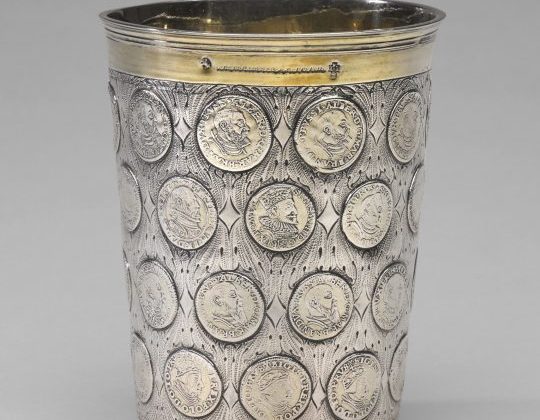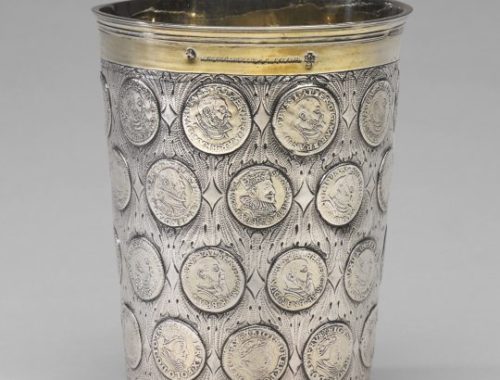Object Number: #205
Berlin c. 1690
Johann Jacob Staude
City’s hallmark: a bear for Berlin (Scheffler Nr. 4a)
Maker’s mark: in the form of a cross, “II” above “S” and underneath a heart for Johann Jacob Staude (Scheffler Nr. 177 (68))
Prussian tax-mark (later): “FW”, in 1809
Height: 16,4 cm, Weight: ca 520 gr.
Lit./fig.: Kriegseisen, Jacek, ‘Podróżny komplet sztućców wykonany przez Johanna Bartolomowicza – złotnika z Lidzbarka Warmińskiego’, p. 93-104 In: Kwartalnik Historii Kultury Materialnej, Year LXIII (63), nr. 1, Warsaw 2015, fig. 7, p. 99.
Detailed Information
Fine Silver Parcel Gilt German Beaker with Inset Coins
The design and the successful integration of the coins to the body of this antique silver beaker make it a very beautiful piece of an object decorated with coins. The beaker has a typical form, yet with some particularities. It has a slightly conical form and the bottom is decorated with a gilded standing ring, exactly like around the profiled rim of the lip. The wall is decorated with four rows of each ten coins from Brandenburg-Prussia and Poland – in total 40 coins. The most part of the coins originate from the sixteenth century and show, among others, coins with portraits of Albert Duke of Prussia (1490-1568) and of Sigismund III Vasa/Sigismund III of Poland (1566-1632). Among the coins, there is wonderfully chiselled stylised foliage and shaped lozenges. On the raised bottom, there is a gilt-coin inset, the so-called “Eight-Brothers Thaler” (Achtbrüdertaler in German) dated “1612” (coin of the Saxe-Weimar duchy). Around the thaler, there is the later inscription “I.F.B : M.M.”. The beaker bears its original gilding inside and has a greater height that the usual beakers.
Silver Beakers with Inset Coins
The great particularity of the beaker lies doubtless in the choice of the coins, as it is always the case for coin objects. Most of the coins are connected to the earlier history of the rulers of Brandenburg-Prussia and Poland. The coins that depict Sigismund III of Poland give an interesting dimension to the object, when one thinks the fact that Sigismund was a painter and goldsmith himself. The coin on the bottom is related to a particular part of the history of Saxe-Weimar, namely the Ernestine line. Such Thalers of the duchy Saxe-Weimar were minted between 1607-1615 and depicted the eight brothers Johann Ernest, Frederick, William, Albert, Johann Frederick, Ernest, Frederick William and Bernhard. On this variation of the coin, there are four brothers depicted on each side. The underage eight brothers were placed under the guardianship of the elector Christian II of Saxe – an Albertine Wettin – in 1605, when their father, Johann II duke of Saxe-Weimar died. After the death of elector Christian II in 1611, they placed under the guardianship of his brother John George I.
Maker
Johann Jacob Staude took the citizen’s oath in 1680. In 1679, he got married to Anna Christina Sölle, daughter of the saddle maker of the court. There is a series of coin objects from the maker in different collections.
Literature
Kriegseisen, Jacek, ‘Podróżny komplet sztućców wykonany przez Johanna Bartolomowicza – złotnika z Lidzbarka Warmińskiego’ (= A Travelling Cutlery Set Made By Johann Bartolomowicz – A Goldsmith from Lidzbark Warmiński (Heilsberg)), p. 93-104 In: Kwartalnik Historii Kultury Materialnej, year LXIII (63rd), nr. 1, Warsaw 2015, fig. 7, p. 99.



